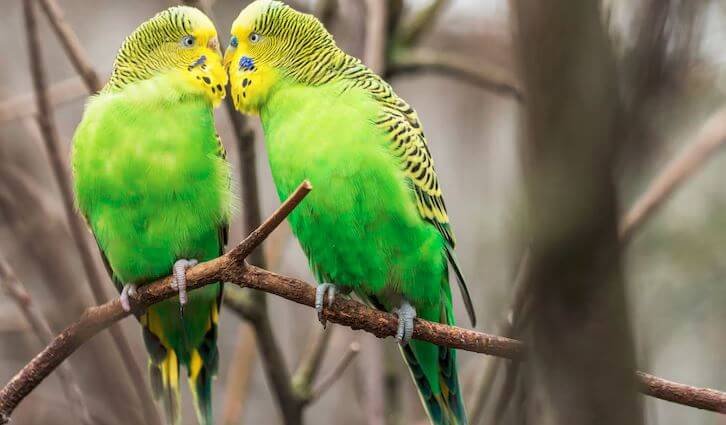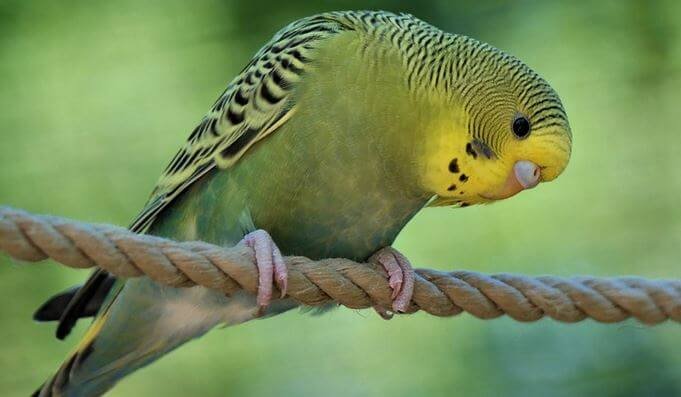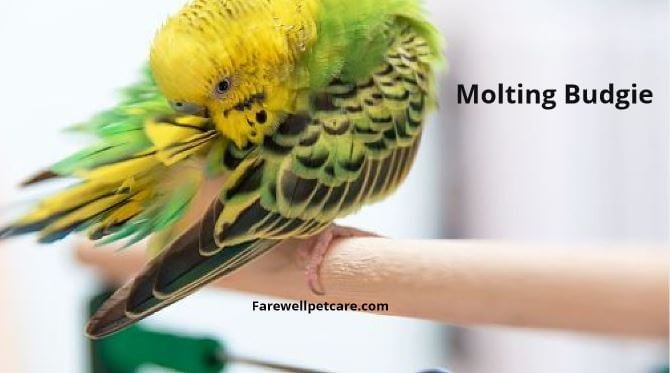Several bird species, including budgies, experience feather molt to stay in a sure-fire flying condition. But how often do budgies molt?
On average, budgies molt at least once a year. However, molting can occur twice a year, depending on the bird’s environmental, hormonal, or dietary changes. Usually, feather molt would last a few weeks to a couple of months.
If you were wondering how it will turn out for your budgie, keep reading this article to learn more, including how you can help your pet bird during this rejuvenation phase.
How Often Do Budgies Molt? The Ultimate Guide

Naturally, budgies molt to prepare a new coat for mating. Most often, molting takes place in spring.
Most budgies shed their feathers only once annually. However, depending on the prevailing environmental and hormonal triggers, some can experience feather molt twice or more times.
If you see your bird shedding its beautiful plumage, that’s perfectly typical. It’s simply welcoming a brand-new look without altering the usual feather color and pattern.
Feather shedding can take a few weeks to complete. Nonetheless, the process can also stretch to a couple of months.
During this phase, your budgie may not feel confident to fly. So, it remains perched for the entire period of the feather molt.
Nearly all budgies molt moderately. This means only unwanted – old and weak feathers shed and gradually replaced with newer ones. That’s not the case for all budgies, as some experience a catastrophic molt.
In a catastrophic molt, the bird sheds all feathers rapidly and simultaneously. This extreme molt is dangerous and limits the bird’s basic natural functions, such as thermoregulation.
Remember, without enough strong feathers, the budgie doesn’t get warmth quickly and would succumb to the harsh environmental conditions if it attempted to fly.
Find Out: Why Is My Budgie Panting? 6 Reasons
What Triggers Feather Molt in Budgies?
Budgie molting is a natural, spontaneous process that your bird will experience yearly. The process has no physical discomfort, even though your bird will depict low energy and suppressed personality. For a new budgie owner, you may wonder what causes molting in birds like budgies.
Generally, molting occurs due to the following triggers:
Preparing for Mating
Before breeding, a male budgie sheds off the old plumage to acquire a fresh look. The new outlook is usually brighter, more attractive, and easier for mates to recognize. Note that a budgie experiencing molting should not mate.
Hormonal Changes
According to scientists, molting in birds is a critical part of their life cycle and a survival mechanism. If the process is disrupted, you could cause serious problems for the bird’s survival. Stress hormones like glucocorticoids may determine how a bird loses its plumage. Hormones such as triiodothyronine and oestrone affect feather growth.
Old and Weak Feathers
Nature drives feather shedding in budgies. It doesn’t matter how clean you maintain your pet budgie’s plumage–the bird will shed it off once the plumage gets old and weary.
New feathers grow to give your pet a vibrant, colorful look that you’ll love.
Parasites and Irritating Insects
Although not the main reason for molting, some parasites can be annoying, especially when they dig into the budgie’s skin.
You can take measures to eliminate such insects and parasites by spraying a bird-friendly chemical. However, budgies would use the molting season to eradicate these parasites.
Do Budgies Act Differently When Molting?

It’s vital to know how budgies behave when molting. Specific symptoms accompany a budgie that’s actively shedding feathers.
The following are the symptoms of a molting budgie:
- The budgie becomes less active than usual. Instead of the normal-flying-around-the-house activities, the bird spends most of the time sleeping.
- You will notice feathers dropping in its cage. At the same time, new feathers will slowly grow on the patched sections of the plumage.
- You can see spiky roots on the head. This is indicative of new feathers growing.
- The bird may spend much time scratching its feathers due to irritation. It may make calls for head scratch therapy.
- Because of appetite loss, your bird may lack interest in the feeds you provide.
- Some budgies can be very aggressive and can even bite.
- Some birds panic with a slight noise or movement in the house
You will need to be careful when diagnosing molting in the bird. Don’t confuse it with other destructive behavior like feather plucking.
Also, ensure that your budgie is not suffering from French molt. This is a type of molting where budgies shed excessive feathers rapidly in a short period. If this is the main problem, take quick action and visit your vet.
French molt could result from infectious microorganisms attacking your bird, poor hygiene, dietary deficiency, use of artificial lights, environmental stress, overbreeding, and more.
How to Help a Molting Budgie
Supportive care is paramount in the phase when a budgie is molting. Your little feather friend is passing through one of life’s toughest experiences.
Molting is a demanding process that may need a higher energy expenditure. That’s why the bird becomes lethargic and sleepy every other time.
The following are the ways to help a molting budgie:
Maintain a Good Dietary Balance
The first question to ask yourself is, what should I feed my molting budgie? A well-established feeding plan is the difference between your bird’s smooth molting process and discomfort or even sickness.
Generally, you want to maintain the already-established feeding program. Some budgies get affected so much that they won’t have an appetite. Others, however, will want to supplement the rapidly increasing energy requirements.
A budgie’s food bowl should contain a blend of proteins and minerals such as:
- Iron
- Zinc
- Magnesium
- Calcium
- Vitamins A, B, and C
These foods enhance the healthy growth of new feathers. They also minimize skin irritations.
Good molting foods for your budgie are boiled eggs, sprouted grains or seeds, and fresh vegetables. Be sure to maintain these foods at all times to avoid malnutrition stress.
Bathe Your Pet Budgie
The itchiness of the skin can make your budgie uncomfortable. Bathing is generally a good practice to tone down the itchiness and enhance relaxation.
You need to place a bowl of warm water in the cage and let the bird do the rest. If it’s not interested, you can spray the cage with a mist of warm water. However, be sure your bird has no problems with misting, as some are easily irritated.
Don’t use cold water to bathe your budgie. Like other birds, budgies depend on the external environment for body temperature regulation. So, you will only be freezing your bird by spraying a mist of cold water on it.
Ensure Your Budgie Gets Enough Sleep and Rest
While molting is a natural process, it can also drain your budgie friend a lot of energy. Make sure you provide enough space for it to rest and sleep.
Proper sleep and relaxation wades off irritation. It could also help reduce the bird’s aggressive behavior at times. Sleeping is a way of recuperating from lost energy.
One thing you should look up to is not disturbing your budgie while it rests. As reflected earlier, budgies can panic when they hear unfamiliar sounds or movements during molting. Avoid such triggers for the well-being of your bird.
Talking about disturbing, avoid anything such as petting and handling during this period. The little spiky roots of feathers are hypersensitive and cause irritation when touched. The worst part is that you could hurt your pet bird just by petting, especially with a focus on the spiky feathers.
Your Patience Counts
It’s not easy handling a molting budgie. But it’s important to remember that your bird needs you most and your patience as never before.
You must provide favorable living conditions even when the response seems poor. The mood of your budgie can be particularly annoying, but you have to put up with that.
All said and done, always seek direction from your veterinarian to stay up to date with anything you need. Don’t forget to keep him in the picture of everything.
Final Thoughts
Understanding the molting process of budgies is essential for their overall health and well-being.
As we’ve explored in this post, budgies molt approximately once or twice a year, and this process can last for several weeks.
While it may be a messy and stressful time for you and your bird, providing the right environment, diet, and care can help make the process smoother.
So, the next time someone asks, “How often do budgies molt?” you can confidently share your knowledge and expertise.

